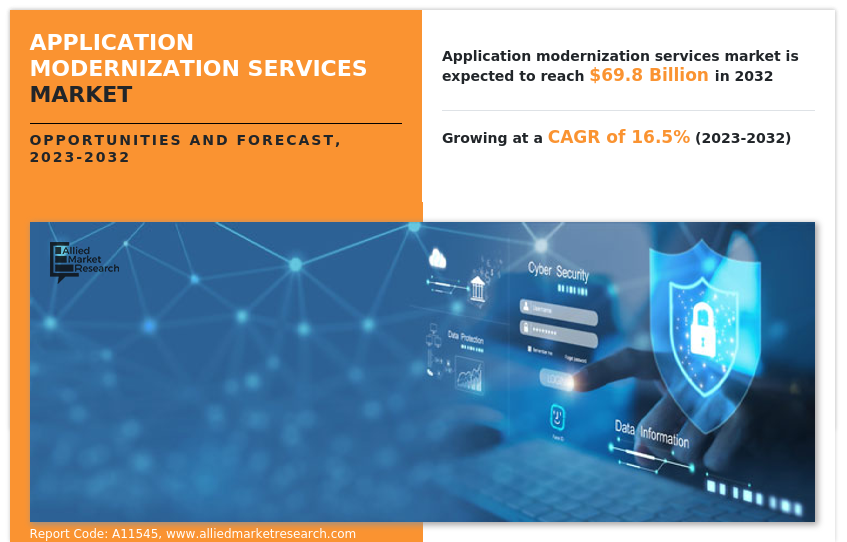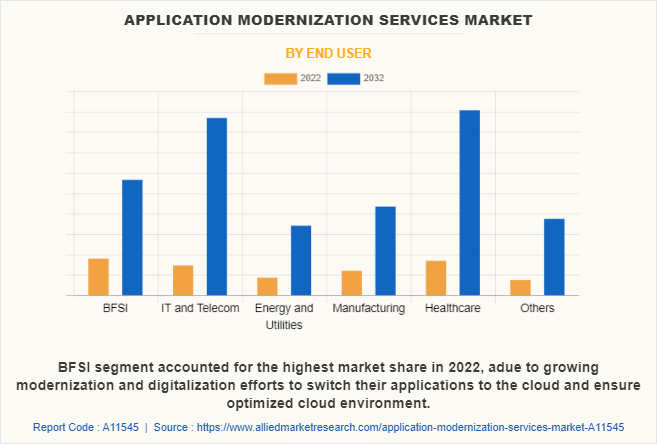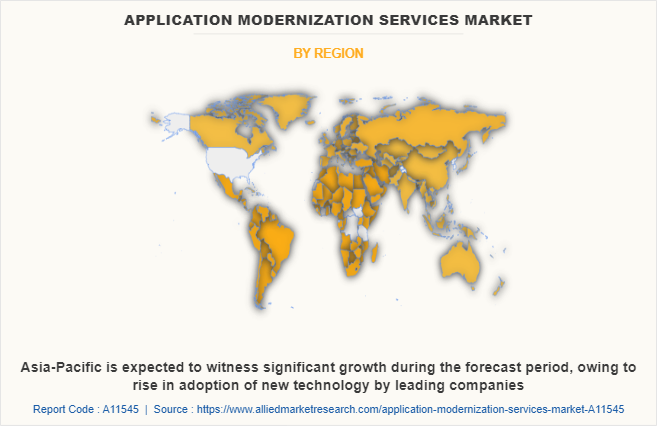Application Modernization Services Market Insights, 2032
The global application modernization services market was valued at USD 15.5 billion in 2022, and is projected to reach USD 69.8 billion by 2032, growing at a CAGR of 16.5% from 2023 to 2032.
Increase in integration of cloud and DevOps technology in application modernization and rise in demand for improved software functionalities are driving the growth of this market. In addition, rise in government support for promoting the use of application modernization services is fueling the application modernization services market growth. However, high implementation cost of application modernization services and lack of skilled employees with expertise in application modernization hamper the growth of this market. Conversely, proliferation of AI and ML technologies and rise in trend of micro services architecture are anticipated to provide numerous opportunities for the expansion of the application modernization services market during the forecast period.

Application modernization services enable switching from outdated platforms or programs to new ones and adding new functionality to give companies latest features. Modernization may comprise transitioning to a containerized or serverless architecture to routinely deploy application code and isolate programs from underlying host environment, making them more effective than virtual machines. Businesses must increase cost-effectiveness and innovation while maintaining or even improving performance and reliability. Most of the companies still rely on outdated gear and software, which drives operating costs and endangers their operations. The key drivers for IT leaders to modernize their outdated programs are shorter time to market, less technical debt, and cheaper operating costs.
The global application modernization services market is segmented into service type, deployment mode, organization size, end-user, and region. By service type, the market is segregated into application portfolio assessment, cloud application migration, application re-platforming, application integration, and others. Depending on the deployment mode, it is divided into On-premise, and cloud. Depending on organization size, it is categorized into large enterprises and small & medium-sized enterprises. By end-user, it is divided into BFSI, IT & telecom, energy & utilities, manufacturing, healthcare, and others. Region wise, it is analyzed across North America, Europe, Asia-Pacific, and LAMEA.

Depending on the end user, the BFSI segment dominated the application modernization services market size in 2022 and is expected to continue this trend during the forecast period, owing to the increase in usage of integrated AI and automation features, allowing businesses to automate routine tasks, such as data entry and customer service. However, IT and telecom segments are expected to grow in the upcoming years, owing to high rate of technological adoption and increasing demand for high-end security among enterprises.

Region wise, North America dominated the application modernization services market share in 2022 and is expected to retain its position during the forecast period, owing to development of infrastructure and rise in investments in application modernization service market. However, Asia-Pacific is expected to witness significant growth during the forecast period, owing to rise in adoption of new technology by leading companies.
The global application modernization services industry is dominated by key players such as Alibaba Cloud, Cisco Systems Inc., Genexus, Qualcomm Technologies, IBM Corporation, Huawei Technologies, Agiletech Vietnam, Elluminati Inc., Line Corporation and Go To. These players have adopted various strategies to increase their market penetration and strengthen their position in the application modernization services industry.
Top Impacting Factors
Surge in Adoption of Mobile Services
Growing adoption of mobile services is one of the prime factors driving the development and popularity of application modernization services market. A large number of people around the globe are using smartphones and mobile devices as the primary means of accessing the internet and conducting everyday activities. According to the Pew Research Center, it is indicated that the smartphones usage has increased among adults, increasing from 13% to 61% in 2021. Thus, such factors lead to the growth of the application modernization services market.
Further, rise in trend of mobile payments and digital wallets has contributed to the growth of application modernization services market, as they enable consumers to process transactions instantly and without any difficulty. According to Christine Wagner from Fidelity National Information Services, Inc. (FIS) an American multinational fintech corporation, it is assessed that checkout process at Point of Sale (POS) by means of mobile wallets has increased by 60% in 2021. Hence, increase in usage of online payments and digital wallets is anticipated to drive the application modernization services market.
Moreover, mobile wallets offer consumers flexibility and convenience by enabling them to quickly make online purchases, withdraw money from ATMs, and send money to others. Therefore, due to their speed, convenience, and security, mobile payments continue to grow increasingly, which further contributes to the market growth.
Advancements in Digital Technologies
Advancements in digital technologies such as artificial intelligence (AI), machine learning (ML), and cloud computing to improve optimization drive the growth of the market. In addition, digital currency has gained high traction in the market in the last few years. In addition, application modernization services combine numerous services, such as transaction management and payment processing, into a single application. Integrating messaging and access to other services with payments is advancing the digitization of formerly used cash-based payments. Therefore, such trends are expected to provide lucrative opportunities for the market growth.
In addition, the retail businesses have shifted toward digital platforms, as the digital economy boomed during the COVID-19 crisis. People are looking for one integral application for this multiple day life services, and therefore, application modernization services find wider application in this scenario due to fact that they integrate multiple services in a single platform, such as online shopping, payments options, food delivery, and ride hailing.
Furthermore, increase in public and private investment is expanding the market growth, as it is a means of diversifying their product offerings and providing a more integrated user experience. For instance, in February 2023, Fierce raised $10 million to fund the application modernization service motivations, allowing consumers to manage their finances from a single platform that reduces complexity in banking services such as checking account and purchase stocks. Thus, such factors are expected to propel the market growth.
End-user Adoption
Growing digitalization in application modernization services development is increasing the interest of end users to use advanced applications, which, in turn, is driving the application modernization services market growth. End-user adoption for application modernization services is primarily influenced by ease of use, trust, and security features available in these applications. On the contrary, application modernization services provide user friendly interface, which is intuitive and straightforward, allowing users to quickly access the features they need to access in apps. Such factors allow end-users to achieve business goals by adopting the application modernization services to streamline their business processes.
In addition, application modernization services are gaining in popularity in the banking, financial services, and insurance (BFSI)industry, as they offer a wide range of financial services and features in a single platform, including the digital payments, banking services, access to investment products and insurance services, Therefore, application modernization services are gaining wide momentum in the BFSI sector to approach for digital banking solutions. For instance, in August 2022, NPST launched application modernization service for the BFSI industry, which aimed to create an application modernization service integrated with a seamless experience by combining all banking, financial, and transactional services into one robust intelligent software. Thus, such innovations further offer a wide range of financial services and features in a single platform, making them a convenient and efficient solution for wide end-user base.
Furthermore, application modernization services are becoming increasingly popular in the restaurant and hotel industry, owing to growing application of online food delivery services In addition, application modernization services can often be used for food ordering and delivery, allowing users to browse menus, place orders, and pay for the meals directly from the app. Application modernization services can further integrate with different food delivery platforms, making it easy for users to access multiple food delivery options in one place. Several private & public firms are working on providing effective application modernization service solution to benefit the restaurant and hotel industry.
For instance, in December 2021, Plaxonic launched the hyperlocal application modernization service namely, Evobee to revolutionize local logistics space. The platform enables home delivery of food, grocery, cab bookings and other appointments services. Therefore, such advanced strategies offer a reliable solution for consumers in the restaurant and hotel industry.
Government Initiatives
Regional governments globe are approaching various initiatives to promote and regulate the use of application modernization services market. For instance, in March 2022, the Government of India planned to launch application modernization service for farmers, combining various digital assets and existing mobile applications created specifically for farmers, according to a representative of the ministry of agriculture and farmers' welfare. Similarly, in August 2022, the Indian Government planned to launch an application modernization service for EV (as the government has installed 479 charging stations under phase-1 of the FAME scheme by July 2022. In addition, 50 charging stations have been installed under phase-2 of the FAME scheme. Such initiatives taken by government authorities are expected to drive the adoption of the application modernization services industry in various countries.
Moreover, the government has been working to improve mobile connectivity and internet access across the country, by promoting a mobile-first approach to serve the digital services to the consumers. For instance, in August 2022, PayNearby incorporates with the Umang, developed by the Ministry of Electronics and Information Technology (MeitY) and National e-Governance Division (NeGD). To offer ease and further the strengthen the government’s vision to make e-governance “mobile first” in India. Overall, such encouraging initiatives approached by government entities are expected to regulate the use of application modernization services globally.
Key Benefits for Stakeholders
The study provides an in-depth analysis of the global application modernization services market forecast along with current & future trends to explain the imminent investment pockets.
Information about key drivers, restraints, & opportunities and their impact analysis on global application modernization services market trends is provided in the report.
Porter’s five forces analysis illustrates the potency of the buyers and suppliers operating in the industry.
The quantitative application modernization services market analysis from 2022 to 2032 is provided to determine the market potential
Application Modernization Services Market Report Highlights
| Aspects | Details |
| Market Size By 2032 | USD 69.8 billion |
| Growth Rate | CAGR of 16.5% |
| Forecast period | 2022 - 2032 |
| Report Pages | 340 |
| By Service Type |
|
| By Deployment Mode |
|
| By Organization Size |
|
| By End User |
|
| By Region |
|
| Key Market Players | Infosys Limited, IBM Corporation, Oracle Corporation, DXC Technology Company, HCL Technologies Limited, Accenture, Atos SE, Cognizant, Wipro, Tata Consultancy Services Ltd. |
Analyst Review
Application modernization services deal with the transfer of legacy applications to new platforms and applications. Additionally, it involves the integration of upgraded functionality to provide the latest features to the business. There are a variety of modernization alternatives available, including re-platforming, re-hosting, recoding, rearchitecting, re-engineering, interoperability, replacement, and retirement. Furthermore, this technology provides various advantages like competitive edge, enhanced compatibility, cloud-native, better efficiencies, robust security, improved user satisfaction, and others.
Key providers in the application modernization service market are Capgemini, Accenture, IBM Technologies, HCL Technologies, TCS, Fujitsu, Wipro, Infosys, and Oracle. Rise in demand for application modernization services resulted various companies to adopted various strategies like product launch, and collaboration strategies to offer various solutions and products related to application modernization service technology. For instance, in 2023, Accenture launched Accenture Cloud First solution assisting clients from all industries to rapidly change into cloud first organizations and accelerating their digital transformation to realize higher value at speed and scale. This solution integrates skills in interactive design, knowledge of the cloud, including migration to the cloud, infrastructure, and application services, ecosystem partnerships, deep industry and cross-industry insights, data and applied intelligence capabilities, and knowledge of operate large IT estates and key business processes in finance, HR, marketing, supply chain, and specialty. Additionally, Atos launched Atos OneCloud platform to actively speed up its company migration to the cloud by providing a one-stop shop with organization and go-to-market strategies tailored to individual industries. This platform assists clients to modernize applications and optimize business processes. Hence, the product launch strategy will push the growth of this market.
Furthermore, some companies adopted collaboration strategies. For instance, on 28th October 2021, Wipro collaborated with Micro Focus and launched Legacy Migration and Modernization Lab collaborating with Amazon Web Services (AWS). The lab combines the technological know-how of Wipro, Micro Focus, and AWS to allow a cloud-ready IT ecosystem by assisting clients in becoming more flexible, lowering operating costs, and mitigating application modernization risks. Moreover, on 26th April 2023 Infosys collaborated with LexisNexis, a data and analytics company to offer comprehensive information services for all of their content, business, and product applications. These services will offer life cycle upgrades, application modernization, application maintenance and support, application development and validation, and content modernization. Therefore, it is evident that the aforementioned strategies will drive the growth of this market for the forecast period.
The global application modernization services market was valued at USD 15.5 billion in 2022, and is projected to reach USD 69.8 billion by 2032
The application modernization services market is projected to grow at a compound annual growth rate of 16.5% from 2023 to 2032.
The key players profiled in the report include Alibaba Cloud, Cisco Systems Inc., Genexus, Qualcomm Technologies, IBM Corporation, Huawei Technologies, Agiletech Vietnam, Elluminati Inc., Line Corporation and Go To.
Asia-Pacific is expected to witness significant growth during the forecast period
Increase in integration of cloud and DevOps technology in application modernization and rise in demand for improved software functionalities are driving the growth of this market. In addition, rise in government support for promoting the use of application modernization services is fueling the market growth.
Loading Table Of Content...
Loading Research Methodology...


